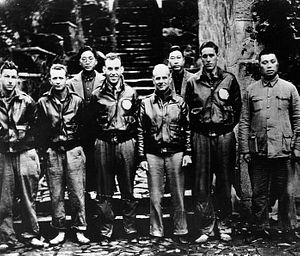At the U.S. Air Force Academy in Colorado Springs a glass-enclosed trophy case used to hold 80 silver goblets (now housed in the National Museum of the U.S. Air Force)*. These goblets were given by the city of Tucson, Arizona to the 80 men who participated in the Doolittle Raid over Japan, 77 years ago this week, on April 18, 1942.
The goblets were used for decades at the men’s annual reunions. The veterans drank to those who died in the raid, and throughout the ensuing decades. Goblets were turned upside down with each man’s passing. Their names were inscribed in both directions, so that they were always readable.
The final goblet will have been turned over now. The last surviving airman of the Doolittle Raid, Richard “Dick” Cole, died last week at the age of 103. He was Lt. Colonel James “Jimmy” Doolittle’s co-pilot.
The story of the Doolittle Raid, which rained bombs and fire on major cities in Japan, killing roughly a hundred,** is well known for the audacity of the plan, the bravery of the American flyers who executed that plan, and the improbable success they achieved.
The bombing and incendiary firestorms that the raid brought to the Japanese homeland created a turning point in Allied favor in World War II. No stronger response to Pearl Harbor could have been imagined, or delivered.
Of course, China was part of the Allied effort in World War II. Americans used bases there, and the airmen were supposed to head inland for China’s wartime capital, Chongqing, in Sichuan province, after releasing their payloads over Japan, and refueling in eastern China.
The plan went awry. The raid marked the first time that B-25 bombers were to be launched from an aircraft carrier, but the USS Hornet was spotted by a Japanese fishing boat. Knowing that all attempts at secrecy were blown, the decision was quickly taken by Doolittle to launch the operation early, but, critically, farther away from the Japanese mainland.
The downside of this decision was that the bombers would probably not have enough fuel to make it back to eastern China safely. In other words, a carefully planned raid had just become a suicide mission. No one backed out.
The raid itself is now legendary. Less well-known is that the mission also created heroes among the Chinese who rescued the beleaguered pilots as they crash-landed and parachuted offshore, and into the fields, rice paddies, and hills of eastern China. Most of the men had never parachuted out of anything.
It also highlights the ways in which politics defines which versions of history are told and taught, and what is purposely left out.
In Quzhou, Zhejiang province, China, a Memorial Hall to the Doolittle Raid was opened only last year. The museum recounts the story of the raid, but also the “the selflessness of Quzhou villagers who helped rescue United States pilots,” up to 51 airmen in all. Thus, while American Doolittle Raiders and their families have been participating in memorial ceremonies and annual reunions for decades, the Chinese government has only in recent years begun to publicly acknowledge the events that took place, and the sacrifices of the Chinese who came to the aid of the Americans.
In earlier years, the revisionist history of the Chinese Communist Party (CCP) made little mention of the Doolittle Raid, and visitors to Quzhou were not regaled with stories of the sacrifices of locals who helped American airmen to safety. The reason, of course, is that the Chinese civilians and soldiers who themselves became heroes in the days after the raid did so under the aegis of the Kuomintang (KMT), the Nationalist forces of Chiang Kai-shek, which the Communist forces of Mao Zedong were committed to defeating as soon as the war ended.
I visited Quzhou on a business trip in 1992. The area was still remote; it had taken five days to drive there from Shanghai, 400 kilometers (250 miles) away. I was welcomed as “one of the few foreigners to come here in the last 50 years.” When I asked who those earlier foreigners had been, the hosts, who included officials of the city government and telephone bureau, quickly said they weren’t sure, and changed the subject.
Of course, they did know. But it was bu fangbian, “inconvenient” — a term often used in Chinese to describe a touchy political topic — to discuss it, and so the truth was left unsaid.
Fast forward more than two-and-a-half decades, and a group from the Children of Doolittle Raiders has visited sites where their airmen fathers were found, treated for their injuries, and led to safety over the following weeks.
As related in the South China Morning Post, “China paid dearly for the rescue. Japan retaliated with massacres in at least three villages, and villagers who helped the Doolittle raiders were tortured and killed… the Japanese launched a Zhejiang-Jiangxi campaign a month after the air attack, which eventually saw 250,000 people in the region killed, according to Zheng Weiyong, a historian in Quzhou and author of Fall in China – Doolittle Tokyo Raid.”
The Chinese government suppressed knowledge of the bravery of Chinese civilians and soldiers in service of the American allies who had risked their lives against a common enemy. Two generations of Chinese did not learn this story.
Perhaps one more goblet needs to be added to the collection in Colorado Springs, this one in the name of the thousands of Chinese who also paid the ultimate price for Doolittle’s Raid and the men who saw it through.
*A previous version of this article did not note the updated location of the goblets.
**A previous version of this article misstated the number of casualties from the bombings.

































